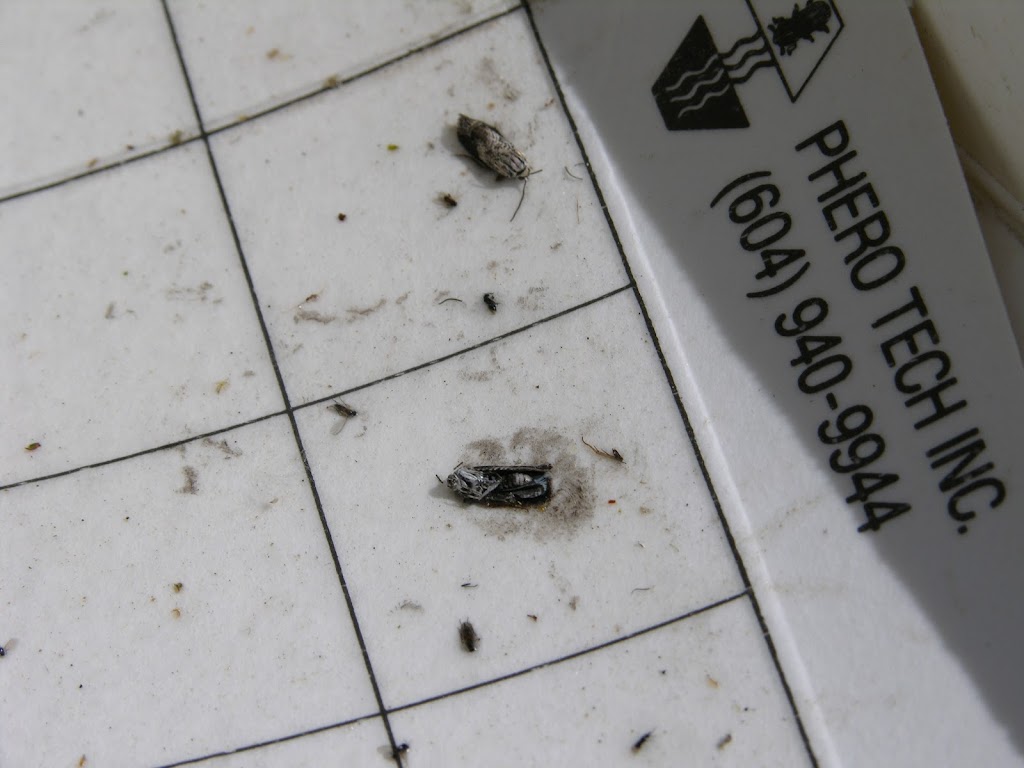Wormy Apples a Problem with Honeycrisp Apples
Q. I have had wormy apples in our ‘Honey Crisp’ apple tree. Last year we had the same problem. I was told to spray a fungicide. I also sprayed Neem oil. I waited until the apples started to form. I still have these worms in every apple on my tree. HELP!!! This is codling moth stuck on the sticky side of a pheremone trap. It is about 3/8 inch long and a true moth. Since the adult is a moth, the juvenile or immature form is a “worm” or larva. When populations are large they produce “wormy apples”. A. I am guessing that you are dealing with codling moth. This is a common pest of apples and pears. They appear as “wormy apples”. They are creamy white and about 3/8 inch long when they are mature. Usually, they have a brown head. They start getting into the fruit when the fruit is small and may continue to feed as the fruit gets larger. You can read more about codling moth control by searching for “codling moth” and “IPM”. https://ipm.ucanr.edu/PMG/PESTNOTES/pn7412.html The most reliable site is from the University of California. If this is codling moth, then picking and get rid of small fruit which is infested is the first step. When the codling moth is flying, the moth will “sting” a small fruit causing it to drop. If it happens when the fruit is larger, it may stay on the tree. Look up for “stung” fruit or look at the ground for fallen fruit. Fruit produced later will have a larger percentage of stung fruit. Look for fruit tree species that are produced and harvested early. Otherwise, their population continues to increase as the apple stays on the tree longer. Apples that stay on the tree longest are the most heavily infested. On the flip side, apples harvested early are the least infested. Populations of this pest increase with each generation produced. In our climate, expect codling moth to have three or four generations each year so start getting rid of infested fruit when the fruit is small. With each generation the numbers of these moths will increase and increase as the year progresses. Start picking and getting rid of infested fruit starting about six weeks after it flowers. You can recognize infested fruit because of the brown frass coming out of it. The places where frass coming from the fruit are called “stings”. Stings are egg-laying sites by the female moth. Fruit that has frass coming from it will either fall from the tree or stay on the tree and get “wormier”. When you remove this fruit early, the population of “worms” has a better chance of staying low. As fruit gets older, the “worms” get bigger and tunnel into the fruit deeper. They might feed on the seeds of these fruit before they pupate into a moth. I have had good luck spraying either Bt or Spinosad several times over one season. Follow label directions. I have also had good luck if I use pheromone traps and get rid of them using these traps. I use one trap for every three or four trees. This codling moth has already exited. Notice the “frass” left behind when it exited. Usually, pheremone traps are used for timing the application of sprays but when populations are low, I have had good luck “trapping them out”. Those traps should be put in the trees when the trees begin flowering or at least a couple weeks after they start to flower. Pheremone traps for codling moth can be bought from several places online. Look for them. The pheromone must be replaced regularly as per the instructions. Those wormy apples you got probably came from a neighbor who did not control them. This is a winged trap. More popular are the three sided “delta traps”. The winged traps, in my opinion, are better for repelling the moths. That is, better for using pheremones to keep fruit free of “worms”. The pheromones have better air circulation in those kinds of traps, the pheremones must be changed out more regularly, and the traps more concentrated. The delta traps are best for monitoring moths and telling you when to spray pesticides.
Wormy Apples a Problem with Honeycrisp Apples Read More »
